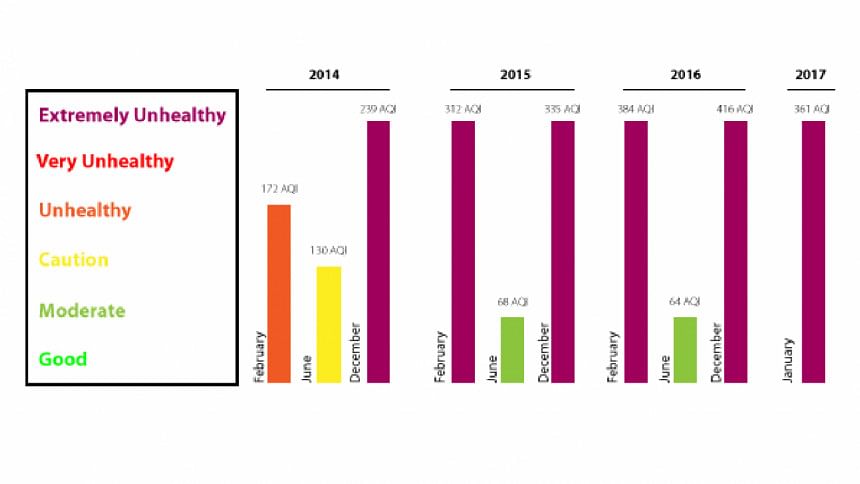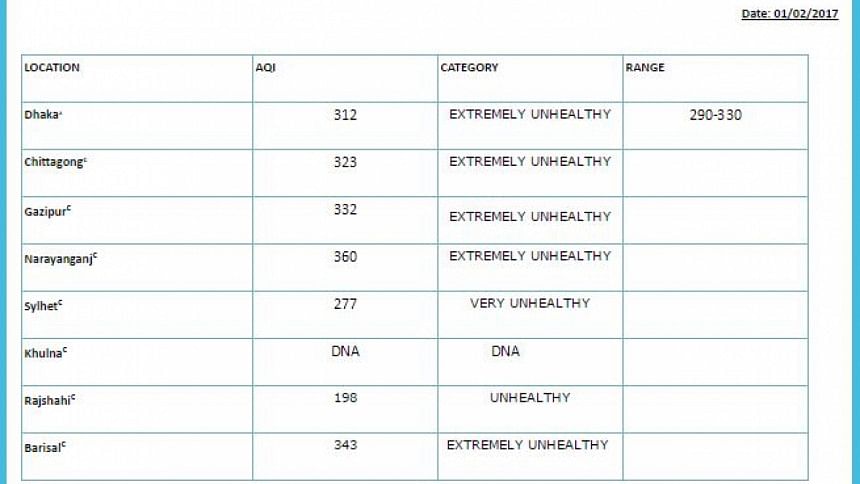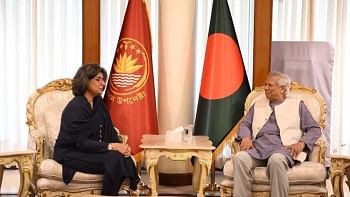Dhaka air pollution: Facts, measures and commandments
For the last three years, the air quality in Dhaka has remained consistently unhealthy during the dry season according to the Department of Environment (DoE). On February 17, 2014, Dhaka’s air quality was measured 172 AQI which is considered unhealthy and on January 25, 2017 it was measured 361 AQI, that is deemed extremely unhealthy according to the standards for Bangladesh (NAAQS).

(Data for earlier years is not available)
In a report prepared by the World Health Organisation (WHO) in 2014, Dhaka took the 23rd place in terms of worst air quality among 1,600 cities of the world.
A public notice by DoE in December of last year states that 58% of the particulate pollutants responsible for the smog in the air of Dhaka city comes from the orthodox brick kilns around and inside Dhaka, 18% from road dust and soil dust, 10% from vehicles, 8% from burning of biomass and 6% from other sources.

THE PROBLEM
The head of the department of Pulmonology of Dhaka Medical College Hospital (DMCH), Biswas Akhtar Hossen says air pollution is one of the main reasons behind respiratory diseases.
People develop diseases like Asthma, COPD, Bronchitis, Bronchiectasis due to long time exposure to dust.
“Currently Bangladesh has 85 lakh patients suffering from Asthma, and almost 75 lakh patients suffering from Bronchitis and COPD.” Dr Biswas told The Daily Star.
He also says there is no doubt that dust pollution is the main reason behind such increased amount of patients of respiratory diseases.
“Dust pollution not only increases the number of patients, it also worsens the intensity of the problem by working as irritants for those who are already suffering from these diseases”
WHAT POLLUTES THE AIR
There are two kinds of pollutants responsible for the pollution of outdoor (ambient) air: gaseous and particulate pollutants.
The presence of gaseous pollutants, like Carbon Monoxide (CO), Sulphur Dioxide (SO2), Nitrogen Oxide (NOx), Ozone (O3) and Methane (CH4) has been found by the DoE in the air of Dhaka city in alarming quantity.
But what is more alarming is the presence of fine dust (particulate pollutants or Particulate Matters) of Sulphate, Nitrates, Ammonia, Sodium Chloride, Black Carbon and mineral in the air, says DoE director, Md Ziaul Haque.Most damaging particles are of the sizes of 10 microns diameter and smaller (PM 10 and 2.5) as they can penetrate and lodge deep inside the lungs. The heavier ones easily fall to the ground, director Md Ziaul Haque explains.
According to the WHO, chronic exposure to such particles increases the risks of developing cardiovascular and respiratory diseases and even cancer in the lung and the urinary tract or bladder in human body.
MEASURES
The Department of Environment of Bangladesh acknowledges the threat and is working to keep air pollution in check under the CASE (Clean Air and Sustainable Environment) project. To abate air pollution risks CASE monitors and publishes the air quality charts on monthly basis.
The DoE director thinks awareness among the general people is also necessary to attain its objective of clean air. In its notice in the leading newspaper of the country, DoE requests citizens to abide by some suggestions.
We can control pollution to a huge extent by using good quality lubricant and fuel for our vehicles, examining their fitness regularly, keeping construction materials covered, planting more and more trees around our homes, checking the continuous digging of roads on both personal and government level, use environment friendly ways in mills and factories.
We know that some parts of China and India have recently been marked among the places with the unhealthiest air. Being asked if Bangladesh is heading that way, Ziaul Haque said, "we should not lose hope". Citing the example of the ban of two-stroke engines in the capital in 2003 which drastically reduced the air pollution in the city, Haque said the government is working to keep the air pollution in check. But he also warned that it is high time to make positive changes about the matter because the situation cannot improve on its own.
HOW MUCH IS IN OUR HANDS
Asked, what measures can the general people take to protect themselves and their family, Dr Biswas, citing the example of the government rules to keep vehicles fit and break bricks for construction away from residential areas, said, the existing laws concerning air pollution in the country lack implementation.
He advised to always were good quality masks available in the markets when outside, to know the risks and the laws and practice them.
“Do not break the rules, and do not let others around you break the rules, protect yourself and family from the health hazards caused by the smog,” the doctor says.
REALITY
In 2013 the government passed the Brick Manufacturing and Brick Kilns Establishment (Control) Act to establish control over brick manufacturing and brick kilns. This Act came into force from 1st July 2014, and permitted two years' time limit to convert the brick kilns into modern technology and relocate them. But how realistic is the act and how far has it been realized after 6 months past the time limit?
In 2009 the DoE declared the four rivers (Turag, Balu, Shitalakkhya, Buriganga) around Dhaka as Ecologically critical area (ECA). According to the act, there can be no brick kilns around ECA. But none of the provisions clarify where the brick kilns can be relocated. As it is prohibited to establish brick kilns in most of the areas (City Corporation, Municipality or Upazila headquarters, public or privately owned forests, sanctuary, gardens or wetlands, agricultural land) it is quite impossible to find out such place in this small sized and densely populated country. As a result, most of the brick kilns are still situated in the northern areas to Dhaka like Gazipur, Tongi, Ashulia. “During the dry season, the wind blows from North to South carrying the pollutants from brick kilns to the city” Haque explains.
As the relocation plan does not seem to work yet, a more environment friendly technology like, Vertical Shaft Brick Kiln (VSBK), Zig-Zag, Hybrid-Hofman Kiln (HHK ) orTunnel Kiln could be adopted. According to DoE the law passed in 2013 provides mandatory provision to manufacture at least 50 percent hollow bricks through modern technology in the brick kilns. But even that has not been realised till now.
So the orthodox brick kilns continue to operate at the edge of Dhaka. “Though the time limit is over, we cannot shut down the brick kilns as a good portion of the country’ s economy depend on the production of bricks.”
That means there is currently no effective measure to control the main source of pollution in Dhaka city.
“The government has to find out a way keeping both the economic and environmental interests of the country in mind” Haque adds.
UNREALISTIC LAW
The conversion of traditional brick kilns into the modern environment friendly ones is a matter of time and expense, tells the treasurer of Bangladesh Brick Kiln Owners’ Association, Raja Shankar, to The Daily Star. “Two years’ time limit is not nearly enough to convert all the brick kilns in the country”, the treasurer says.
Moreover, almost Tk eighty lakh investment is necessary to convert a traditional drum chimney brick kiln into a Zig-Zag one, and fifty crore to convert it into a technologically advanced and more environment friendly one, Shankar explains. “Government has not provided the brick kiln owners with any economical support, very few of them are capable of investing so much on their own,” says Shankar. As a result, two thousand brick kilns have been converted into Zig-Zag and not more than fifty have been converted into other more expensive systems among the four thousand two hundred licensed brick kilns in the country, according to the treasurer.
Asked about the kilns near Dhaka at the north of the city, the treasurer said most of those are not even licensed and are still running in the traditional harmful technology.
“We too want to protect the environment, but we cannot do that on our own without government’s help,” he says.
“Without any plans of implementation, the existing law seems very unrealistic” the treasurer of Bangladesh Brick Kiln Owners’ Association concludes.
OTHER CITIES
Sadly, the quality of air in the other major cities of the country is also not healthy. Apart from Dhaka, Narayanganj and Gazipur, the air quality in the port city of Chittagong and Barishal is also extremely unhealthy according to the DoE’s latest report published in January, 2017. And the air in Rajshahi and Sylhet have been categorised as unhealthy.

It’s high time to stop being comfortable about the pollution in the air. Otherwise soon enough, Dhaka will be unlivable.

 For all latest news, follow The Daily Star's Google News channel.
For all latest news, follow The Daily Star's Google News channel. 



Comments